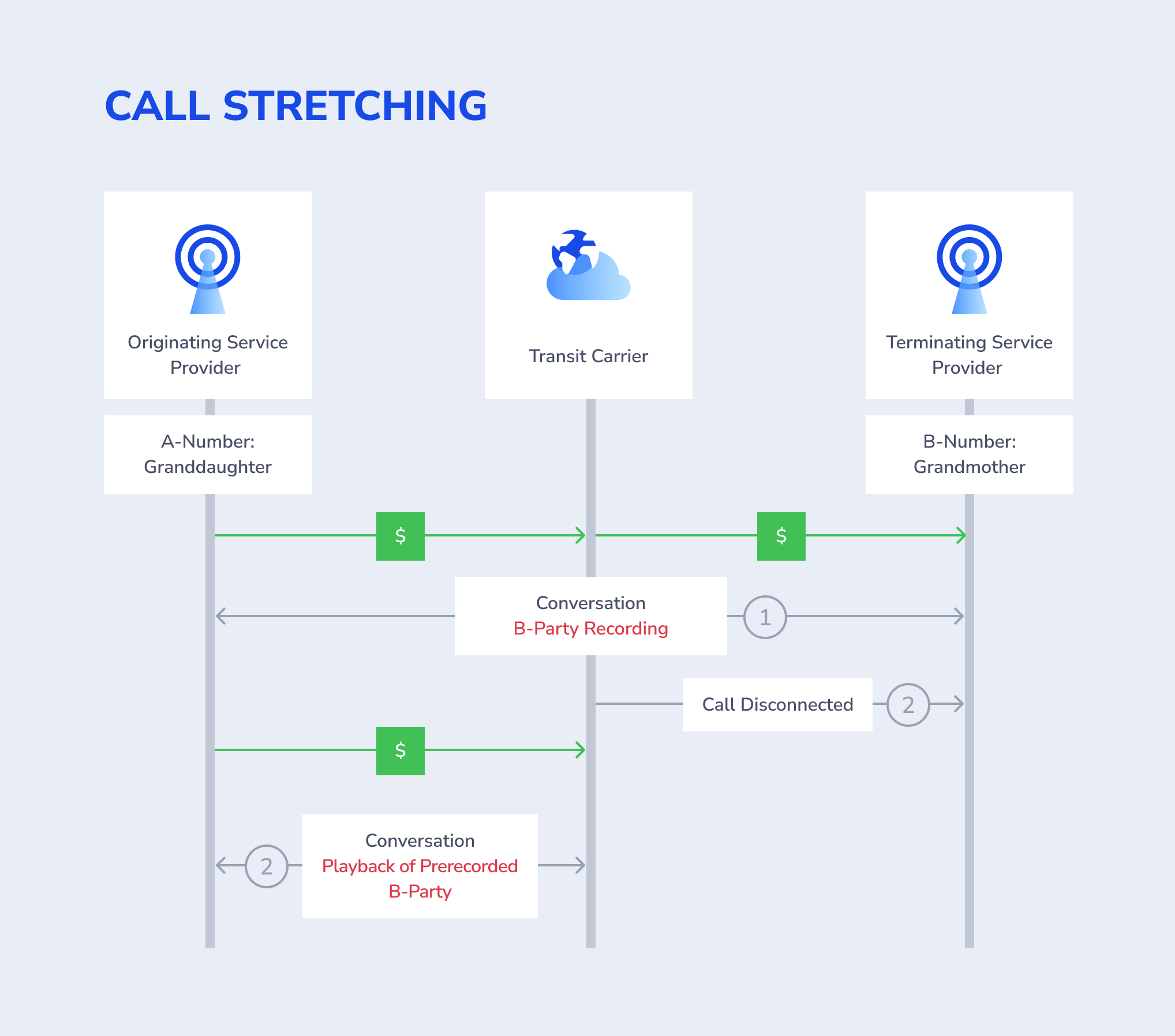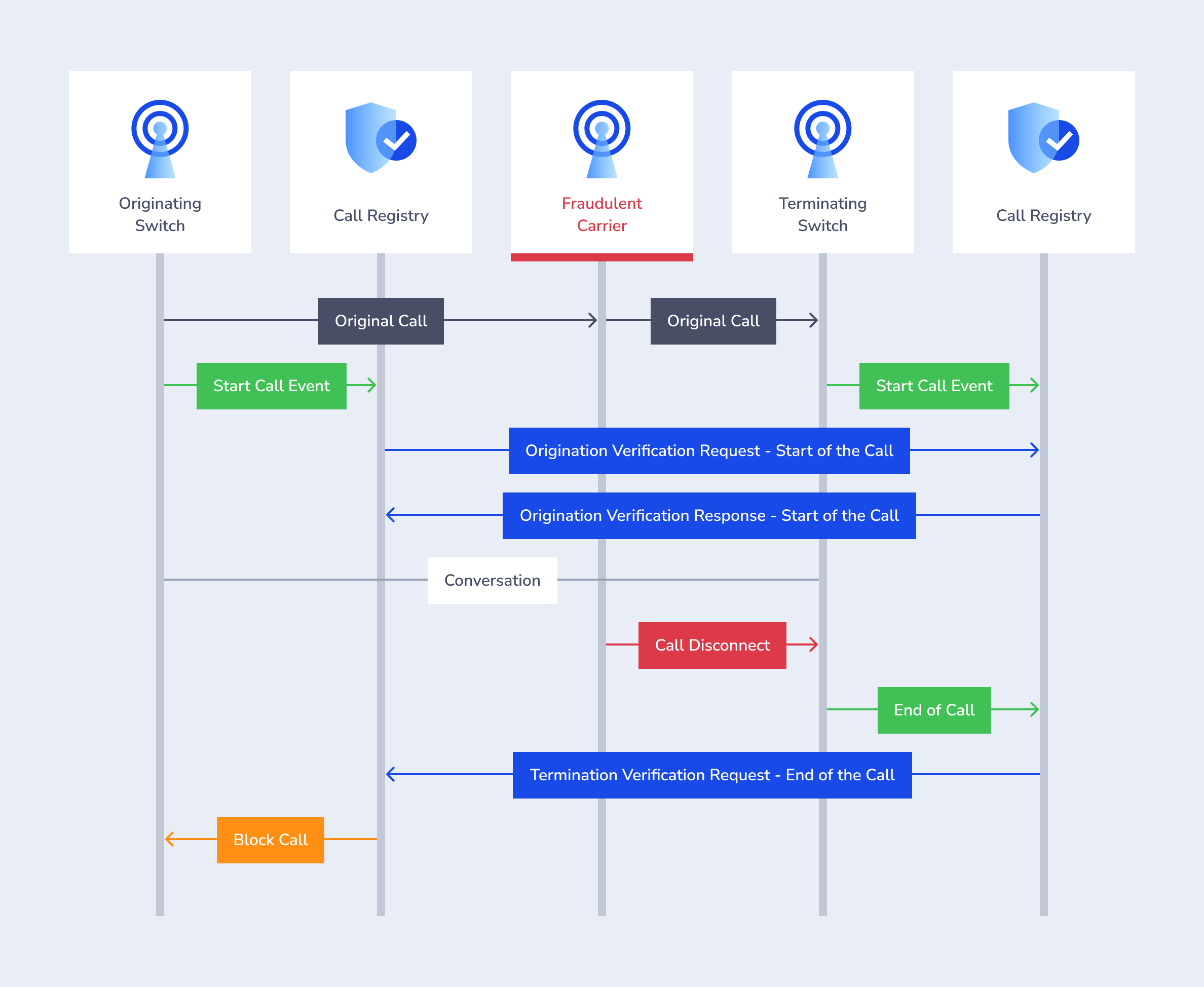
Understanding and Preventing Call Stretching Fraud in Telecom
Knowledge base
Share
Call Stretching Prevention. Protect from Fraud with AB Handshake.
The telecommunications industry is becoming increasingly digital, and fraudsters are constantly creating sophisticated new ways to exploit networks and drain value. One technique that persists is call stretching fraud, a subtype of wholesale telecom fraud. With millions of dollars at stake across multiple carriers, it's crucial to detect and prevent such damaging fraudulent schemes.
This article explores the technical details and financial impacts of call stretching fraud. It examines the most effective strategies employed by leading telcos to combat these fraudsters, focusing on maintaining network integrity through diligent fraud monitoring and prevention.
What is Call Stretching Fraud?
Call stretching fraud involves artificially extending the duration of a call beyond its natural termination point, encompassing various levels of sophistication.
In its simplest form, the carrier knowingly disregards the fact that the called party has already terminated the call, keeping it active for several extra seconds. Each additional second of extended call time results in financial gains for the fraudster, while inflicting financial losses for those not involved in the fraudulent scheme.
The Advanced Call Stretching Scheme
In recent years, fraudsters have developed more elaborate call stretching techniques. One such method involves recording the B-party’s voice during the call. After disconnecting the call on the terminating side, the intermediate carrier plays back the recorded B-party voice to the A-party. This illusion convinces the A-party that the call is still active, consequently keeping them on the line longer and accumulating charges that benefit the fraudsters.
Call Stretching Fraud in Action
To better understand call stretching, consider this example:
A granddaughter (subscriber A) makes an international call to her grandmother (subscriber B). During their lengthy conversation, a fraudulent carrier secretly records the grandmother's voice.
At a chosen moment, the fraudster deliberately interrupts the call for the grandmother. Simultaneously, they start to play back the grandmothe's recorded voice to the granddaughter.
Why execute such an elaborate process? Charge inflation. By executing this scheme, the fraudster will earn a much greater margin compared to a regular, legitimate call.

The Impact of Call Stretching Fraud on Telcos
Call stretching significantly damages operators by compromising customer trust and inflicting financial damage. This fraud subjects end users to excessive charges and violates privacy through unlawful recording of conversations. Unfortunately, the originating operator not only faces financial losses from the fraud but must also address customer complaints. Privacy breaches often cause irreversible damage to service providers, potentially resulting in legal disputes and international media scrutiny.
The CFCA 2021 report notes that call stretching significantly contributes to losses from International Revenue Share Fraud (IRSF), estimated at $6.69 billion annually. While the exact loss attributable to call stretching is challenging to quantify, as it is currently only detected by AB Handshake technology, its impact is significant. Discrepancies in call durations across operators' billing systems involved in routing these calls can lead to trouble-ticketing and payment disputes. On each side, both procedures exhaust valuable resources. Detecting call stretching fraud is complicated, with AB Handshake being the only system capable of doing so.
Why Do Traditional Fraud Management Systems Fail to Prevent Call Stretching?
As telecom operators improve their fraud detection mechanisms, fraudsters also adapt to remain unnoticed. Call stretching is a type of fraud that traditional FMS cannot detect.
The most challenging aspect of call stretching detection is that it is masked inside a legitimate international phone call. While traditional FMS can analyze call parameters like ACD and ASR, and can detect calls with illegal routing or those generating sudden peaks in traffic volume or terminating in suspicious destinations, they fail to identify discrepancies associated with call stretching. This is because, in a call stretching scheme, the initial call from A-number to B-number is legitimate, with only the end part of the call being fraudulent.
Detection and prevention of call stretching requires real-time matching of call events by both originating and terminating operators.
Call Stretching Fraud Prevention and Detection: The AB Handshake Solution
Call Stretching can only be prevented if the originating operator informs the terminating operator about changes in call status. Consequently, when the originating party disconnects, the terminating operator is immediately notified about the call status change, with opportunity to act accordingly.

AB Handshake's Call Validation is the only system capable of ensuring real-time notification to the terminating operator regarding call status changes.
Through AB Handshake's Call Validation solution, all call events, including call end messages, are exchanged in real time between the originating and terminating networks. This exchange of call details cannot be manipulated by any intermediaries. Consequently, when the originating party sends a notification to the terminating party to disconnect the call, even if the corresponding message was deliberately delayed by one of the transit carriers, inflated charges are prevented.
AB Handshake Call Validation detects call stretching and other fraud with 100% accuracy and can be configured to automatically block fraudulent calls prior to delivery. It provides full transparency and visibility of original numbers. Additionally, Call Validation offers impartial evidence of which transit operator delivered the fraudulent call to the operator's network, enabling optimized routing.
The recent 2023 ITU CxO Meeting communiqué states the growing need for global coordination and the prompt implementation of real-time call validation as a universal solution. AB Handshake aligns with this direction.
Learn more about the future of telecom fraud prevention, and how AB Handshakes vision matches that of the ITU CxO committee.
For more details on Call Validation, visit this page.
Alternatively, get in touch to book a meeting with our team.